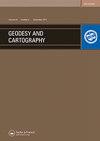Obituary for Prof. Dr. Hab. Wojciech Pachelski. Two years death anniversary
IF 2.1
Q3 REMOTE SENSING
引用次数: 0
Abstract
Fig. 1. Prof. Wojciech Pachelski Professor Wojciech Pachelski was born in April 1939 in Warsaw. He graduated the Warsaw Geodesic Secondary School and then the Faculty of Geodesy and Cartography of the Warsaw University of Technology in 1961. He worked as an assistant at the Institute of Geodesy and Cartography in 1961–1962, then (1962–1972) as an assistant professor at the Computing Center of the Polish Academy of Sciences in Warsaw. He defended his doctoral dissertation Some Solutions for Processing Observational and Orbital Numerical Data of Artificial Earth Satellites (Figure 2) at the Faculty of Geodesy and Cartography of the Warsaw University of Technology in 1966. Professor Tadeusz Trajdos, an outstanding Polish mathematician, a longtime employee of our University, was his thesis supervisor. Wojciech Pachelski, Ph.D. was employed at the Institute of Mathematical Machines in Warsaw (as an assistant professor – Head of Department) in 1972–1977. His work subjects included: applications of digital machines to the processing of satellite surveying and space experiments data; development of the sequential alignment method and its application to the experimental satellite triangulation network. In the following years (1977–2008) he worked as an assistant professor and professor (from 1994) at the Space Research Center of the Polish Academy of Sciences, where he continued research in the above fields. During this period, Professor Wojciech Pachelski’s textbooks for learning programming in Fortran – known all over Poland – were published. From these books, older MUT employees (including the author of this biography) learned Fortran IV programming for ODRA 1300 machines and Fortran 77.哈博士教授的讣告。Wojciech Pachelski。两周年忌日
本文章由计算机程序翻译,如有差异,请以英文原文为准。
求助全文
约1分钟内获得全文
求助全文
来源期刊

Geodesy and Cartography
REMOTE SENSING-
CiteScore
1.50
自引率
0.00%
发文量
0
审稿时长
15 weeks
期刊介绍:
THE JOURNAL IS DESIGNED FOR PUBLISHING PAPERS CONCERNING THE FOLLOWING FIELDS OF RESEARCH: •study, establishment and improvement of the geodesy and mapping technologies, •establishing and improving the geodetic networks, •theoretical and practical principles of developing standards for geodetic measurements, •mathematical treatment of the geodetic and photogrammetric measurements, •controlling and application of the permanent GPS stations, •study and measurements of Earth’s figure and parameters of the gravity field, •study and development the geoid models,
 求助内容:
求助内容: 应助结果提醒方式:
应助结果提醒方式:


